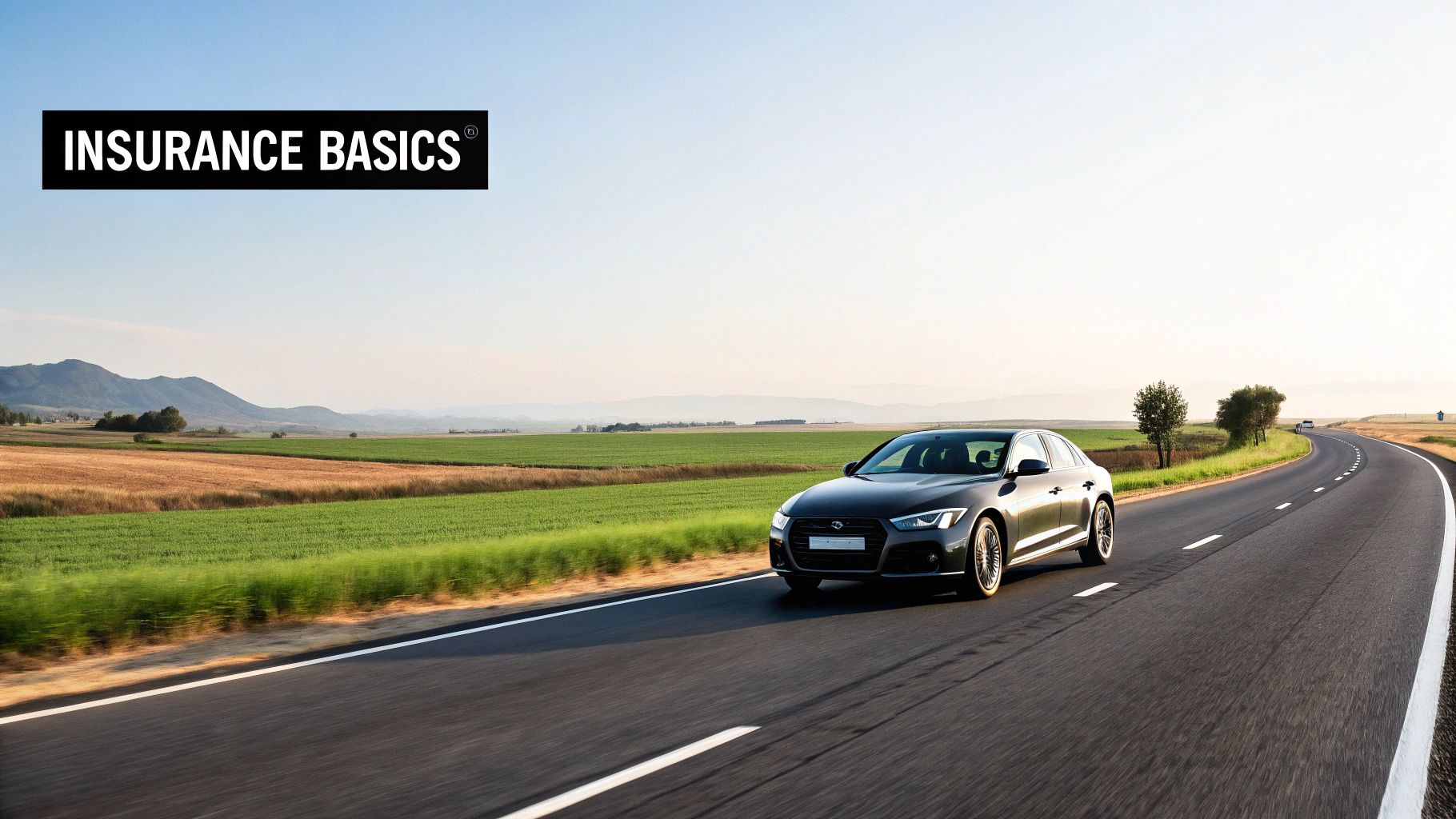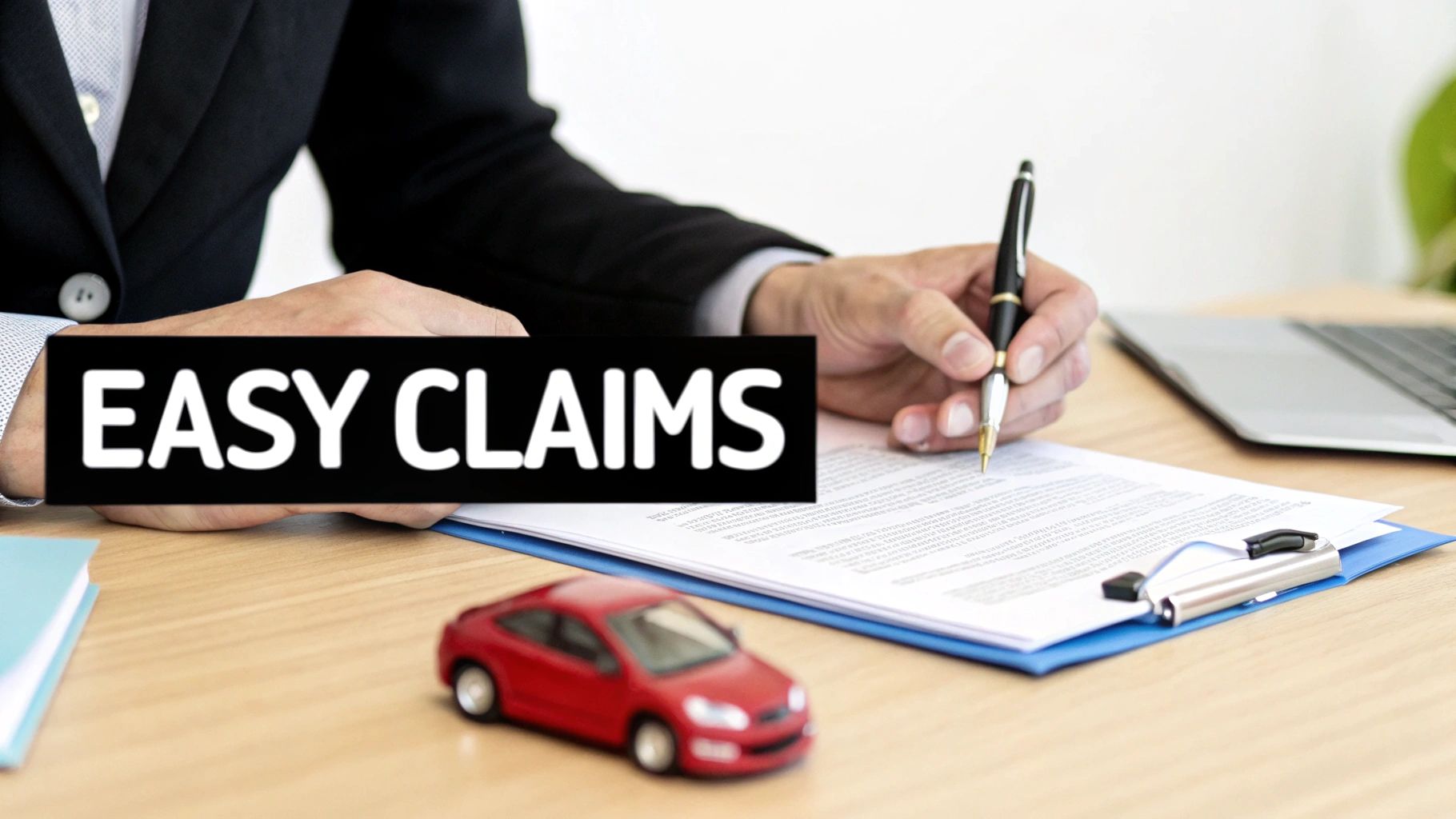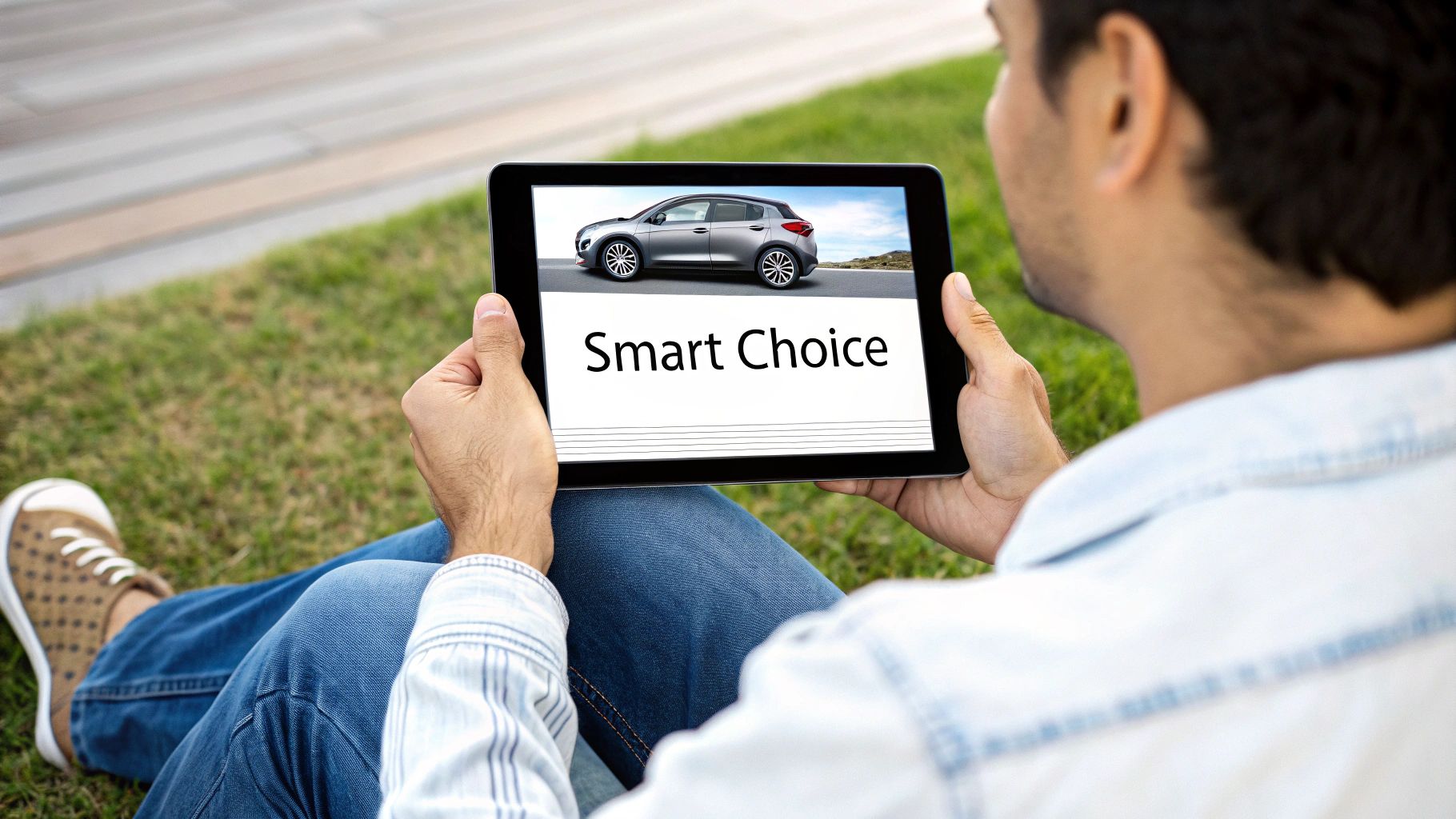What Is Car Insurance: Beyond the Basics

Understanding car insurance involves more than simply acknowledging it as a legal requirement. It's about recognizing its crucial role as a financial safety net, much like an airbag cushioning the impact of a collision. This protection lessens the financial blow of potentially devastating expenses.
Car insurance coverage extends beyond damage to your own vehicle. It also addresses your liability for injuries and damages to others involved in an accident. This comprehensive understanding is essential for making well-informed decisions about your coverage needs.
Why Car Insurance Matters: More Than Just a Legal Necessity
Car insurance isn't merely a checkbox on a legal to-do list. It safeguards your financial well-being from unexpected events. Imagine the financial burden of covering another driver's medical bills after an accident where you are at fault.
Without sufficient insurance, this scenario could lead to substantial debt and long-term financial instability. Car insurance provides crucial financial protection against accidents, theft, and other vehicle-related incidents.
The importance of insurance is reinforced by legal mandates, such as third-party liability coverage, often compulsory in many jurisdictions. In 2023, third-party liability insurance held a significant revenue share within the global auto insurance market. For more detailed information, you can explore this further here. The right coverage offers peace of mind, letting you focus on driving without constant worry.
Verifying and Understanding Your Coverage
Car insurance verification often involves a Certificate of Insurance (COI). This document summarizes your coverage details, serving as convenient proof of insurance. But simply possessing a COI is not sufficient.
Understanding the specifics of your policy is paramount. This includes knowing your deductible, coverage limits, and the types of incidents covered. Actively reviewing your policy ensures you are fully aware of its provisions.
Protecting Yourself and Others: The Scope of Car Insurance
Car insurance protection goes beyond just your own vehicle. It extends to financial coverage for damage you might cause to other people's property or injuries you might inflict upon them. Furthermore, it can protect you if you are involved in an accident with an uninsured or underinsured driver.
These protections underscore the interconnectedness of driving and the shared responsibility it entails. Adequate car insurance safeguards not only you but also contributes to a safer and more financially secure environment for everyone on the road.
Coverage Types: Building Your Protection Framework

Understanding car insurance involves a careful examination of the different coverage options. Each type plays a specific role in your overall financial protection, shielding you from various risks on the road. This section explores the essential coverage types, clarifying how they function and why they are important.
Liability Coverage: Protecting Your Assets
Liability coverage is fundamental to any car insurance policy. It safeguards your finances if you cause an accident resulting in injury or property damage to another person. This coverage pays for their medical expenses, repair costs, and legal fees if they choose to sue. Liability coverage not only protects others but also shields your assets from being used to cover these costs.
For instance, if you cause a major accident leading to significant medical bills for the injured party, your liability coverage can prevent them from pursuing your personal savings or property. This protection is crucial for preserving your financial well-being after an at-fault accident.
Collision Coverage: Repairing Your Vehicle
While liability coverage protects others, collision coverage focuses on your vehicle. It helps pay for repairs if your car is damaged in a collision with another vehicle or object, even if you are at fault. This coverage is particularly valuable for newer vehicles, where repair costs can be substantial.
Imagine hitting a guardrail and damaging your bumper. Collision coverage would cover the repair costs, minus your deductible. Choosing the right deductible—the amount you pay out-of-pocket before coverage kicks in—is essential for balancing your premium costs and potential out-of-pocket expenses.
Comprehensive Coverage: Beyond Collisions
Comprehensive coverage offers broader protection than collision coverage, safeguarding your vehicle from various incidents beyond collisions. This includes damage from theft, vandalism, natural disasters like hailstorms, and even falling objects. It acts as a comprehensive safety net for your car against non-collision events.
This coverage can be invaluable if your car is damaged by a hailstorm or stolen from a parking lot. These unexpected events can create significant financial strain without comprehensive coverage. Protecting your vehicle with this coverage provides peace of mind against a range of unpredictable incidents.
Uninsured/Underinsured Motorist Coverage: Closing the Gap
Even with comprehensive car insurance, you’re still vulnerable to drivers who may lack sufficient coverage or have none at all. Uninsured/underinsured motorist coverage addresses this gap. If you're hit by an uninsured or underinsured driver, this coverage helps pay for your medical bills and vehicle repairs.
This protection is particularly crucial considering the number of uninsured or underinsured drivers on the road. This coverage offers an extra layer of protection, preventing you from bearing the financial burden of someone else's lack of responsibility.
Personal Injury Protection (PIP): Covering Medical Expenses
Personal Injury Protection (PIP) helps pay for medical expenses for you and your passengers, regardless of who is at fault in an accident. It can also cover lost wages and other related expenses. PIP coverage can be especially helpful in states where it's required, simplifying the process of handling medical bills after an accident.
This streamlines the claims process and minimizes your financial burden, particularly in situations where determining fault might be complicated or time-consuming. PIP provides immediate medical coverage, ensuring you receive necessary treatment after an accident.
To better understand the different coverage options, consider the following comparison:
Car Insurance Coverage Types Comparison
| Coverage Type | What It Protects | Required/Optional | Ideal For |
|---|---|---|---|
| Liability | Others' medical expenses & property damage | Often Required | Protecting your assets if you're at fault |
| Collision | Your vehicle damage in a collision | Often Optional | Repairing your car after an accident |
| Comprehensive | Your vehicle damage from non-collision events | Often Optional | Protecting your car from theft, vandalism, weather, etc. |
| Uninsured/Underinsured Motorist | Your expenses when hit by an uninsured driver | Varies by State | Protecting yourself from drivers without enough coverage |
| Personal Injury Protection (PIP) | Your & your passengers' medical expenses | Varies by State | Covering medical expenses regardless of fault |
This table summarizes the key features of each coverage type, helping you make informed decisions about your car insurance policy. Choosing the right combination of coverages is essential for comprehensive protection.
By understanding these coverage types, you can build a car insurance policy tailored to your needs and risk tolerance. Each type serves a distinct purpose, empowering you to navigate the intricacies of car insurance with confidence. This knowledge allows you to choose a policy that offers genuine protection when you need it most.
The Premium Puzzle: What Drives Your Rates

Now that we've explored the different types of car insurance, let's dive into the factors that determine your individual premium. Understanding these elements helps you make informed decisions and potentially lower your car insurance costs. It's important to remember that a complex combination of variables goes into calculating these premiums.
Location, Location, Location: How Your Address Affects Your Rates
Your location surprisingly impacts your car insurance premium. Areas with higher instances of accidents, theft, or vandalism tend to have higher premiums. For example, urban areas with heavy traffic congestion might experience higher rates than rural areas due to the increased risk of accidents.
Additionally, locations prone to natural disasters like floods or hailstorms can also see increased premiums. This reflects the higher probability of vehicle damage from such events.
Vehicle Value and Safety: The Impact of Your Car Choice
The car you drive significantly influences your insurance rates. A more expensive car typically costs more to insure due to the higher potential payout for repairs or replacement. This makes your vehicle choice a key factor in determining your car insurance costs.
A car's safety features also play a crucial role. Vehicles equipped with advanced safety features, such as anti-theft systems and collision avoidance technology, can often qualify for lower premiums. Insurers recognize that these features minimize accidents and reduce the likelihood of claims.
Driving History and Experience: The Weight of Your Past
Your driving history is a primary factor in setting your car insurance rates. A record of accidents or traffic violations indicates a higher risk to insurers, often leading to higher premiums. Likewise, less experienced drivers, especially teenagers, typically pay more due to statistically higher accident rates.
This underscores the importance of safe driving habits. Maintaining a clean driving record can significantly lower your premiums over time by demonstrating a lower risk profile to insurance providers.
Personal Factors: Other Elements That Influence Premiums
Several other personal factors can affect your premium. Your age, marital status, and even credit score can come into play in certain regions. These factors contribute to the substantial growth of the car insurance market in recent years.
As of 2023, the market size was estimated at USD 730.1 billion. It's projected to grow at a CAGR of 13.7% from 2024 to 2030. This growth is fueled by increasing accidents, rising vehicle sales, and the rising adoption of electric vehicles. You can find more information on the car insurance market here. Understanding these diverse influences provides a comprehensive perspective on what shapes your car insurance costs.
To better understand how these factors interact, let's look at the following table:
Factors Affecting Your Car Insurance Premium
This table presents the key factors that influence car insurance rates and their relative impact on your premium costs.
| Factor | Impact Level | Why It Matters | Ways to Improve |
|---|---|---|---|
| Location | High | Areas with more accidents, theft, or natural disasters have higher rates. | Consider moving to a lower-risk area if feasible. |
| Vehicle Value and Safety | High | More expensive and less safe cars cost more to insure. | Choose a car with strong safety features and a moderate value. |
| Driving History | High | Accidents and violations raise premiums. | Maintain a clean driving record by following traffic laws. |
| Age and Experience | Medium | Younger, less experienced drivers statistically have more accidents. | Gain driving experience and take defensive driving courses. |
| Marital Status and Credit Score | Medium (in some regions) | Some insurers use these factors in risk assessment. | Maintain good credit and consider the potential impact of marital status. |
This table summarizes the main drivers behind your car insurance premium. By addressing the controllable factors, you can positively influence your insurance costs.
Taking Control of Your Premium: Strategies for Savings
While some factors are outside your control, others provide opportunities to save. Maintaining a good driving record, selecting a car with robust safety features, and comparing rates from different insurers are all effective strategies.
By understanding the factors that determine your premiums, you gain valuable insights into car insurance and how it works. This knowledge empowers you to choose appropriate coverage and minimize costs without compromising necessary protection.
Selecting Coverage That Actually Protects You

Selecting the right car insurance involves more than just finding the lowest price. It requires a careful evaluation of your individual needs and choosing coverage that offers genuine protection in a variety of situations. This includes understanding your risk profile, determining appropriate coverage limits, and recognizing the subtle but important differences between policies. This section will guide you through the process of building a car insurance policy that provides true value and security.
Identifying Your Risk Profile: Assessing Your Needs
The first step towards securing the right coverage is understanding your unique risk profile. This means considering factors like your driving habits, where you live, and the value of your vehicle. For example, if you primarily drive in busy city centers, your chances of being involved in an accident might be statistically higher than someone who mainly drives in less congested rural areas.
Furthermore, the value of your car plays a significant role in determining your coverage needs. A newer, more expensive vehicle will likely require higher coverage limits compared to an older, less valuable one. This initial assessment helps ensure your coverage aligns with your specific circumstances, offering the right level of protection.
Determining Appropriate Coverage Limits: Avoiding Financial Exposure
Choosing the right coverage limits is vital to protect yourself from potentially devastating financial consequences after an accident. Liability coverage, which protects you if you are at fault, should have limits sufficient to cover potential medical bills and property damage for other parties involved. Setting these limits too low can expose you to personal liability for any remaining costs.
In addition, be sure to research your state's minimum requirements for car insurance. While meeting these minimums fulfills your legal obligations, they often prove insufficient in covering all expenses associated with a serious accident. Opting for coverage that surpasses these minimums offers a greater level of financial security.
Recognizing Quality Differences: Beyond the Basics of Car Insurance
It's important to remember that not all car insurance policies are the same. Even policies that appear similar on the surface can have substantial differences in their terms and conditions. Carefully review the policy's details, paying close attention to exclusions, deductibles, and the claims settlement process. For instance, certain policies might include valuable benefits like roadside assistance or rental car reimbursement, while others do not.
Therefore, comparing policies solely based on price can be misleading. A slightly higher premium might offer significantly better coverage and benefits, ultimately providing better value. Understanding these nuances allows you to select a policy that offers comprehensive protection and peace of mind.
Case Studies: Learning From Real-World Scenarios
Real-world accident scenarios illustrate the importance of having the right coverage. Imagine a driver with minimal coverage causing an accident that results in serious injuries to another party. The limited coverage may not be enough to cover all the medical costs, leaving the at-fault driver personally responsible for the remaining balance.
Such situations demonstrate how inadequate coverage can lead to unexpected financial hardship. This underscores the need to carefully assess your coverage needs and select a policy that offers adequate protection for a wide range of circumstances.
Balancing Premium Costs and Meaningful Protection: A Personalized Approach
Choosing car insurance is about finding the optimal balance between affordable premiums and robust protection. While opting for the cheapest policy is tempting, it's crucial to confirm that it offers sufficient coverage for your individual needs. This personalized approach to car insurance ensures you're not overpaying for unnecessary add-ons while also avoiding the risk of being underinsured in a critical situation. Ultimately, the goal is to have peace of mind knowing you're adequately protected while on the road.
Navigating Claims: From Crash to Resolution
After a car accident, knowing the next steps can be daunting. This section explains the car insurance claim process, from the immediate aftermath of an accident to the final settlement. We'll break down this often complex journey into manageable steps.
Immediate Steps After an Accident: Protecting Your Interests
Safety is the top priority after an accident. Check for injuries and move to a safe location if possible. Contact the police to file a report, even if the accident appears minor. This official documentation is essential for your insurance claim.
Document the scene thoroughly. Take photos and videos of the damage to all vehicles involved, as well as the overall accident scene. Gather contact information from any witnesses. Their accounts can be valuable during the claim process. These initial actions protect your rights and ensure accurate documentation.
Filing a Claim: Initiating the Process
Contact your insurance company promptly to report the accident and initiate your claim. Provide all the gathered information, including the police report, photos, videos, and witness contact details. A clear explanation of the accident is vital for efficient processing.
Your insurer will assign a claims adjuster to your case. The claims adjuster investigates the accident, assesses the damage, and determines the settlement amount. Cooperating with the adjuster and promptly providing requested documents ensures timely processing.
The Claims Investigation: Assessing the Damage
The claims adjuster investigates the accident to determine fault and the extent of the damages. This might involve inspecting the vehicles, interviewing witnesses, and reviewing the police report. The goal is to establish a clear understanding of the incident and who is responsible.
Maintain detailed records of all communication with the insurance company and the claims adjuster. This documentation can be crucial if disputes arise during the process. Staying organized throughout the investigation promotes a smoother, more transparent experience.
Settlement Negotiations: Reaching a Fair Outcome
After the investigation, the insurance company will present a settlement offer. The offer is based on the adjuster's assessment of damages and your policy's coverage. If you disagree with the offer, you can negotiate. It's your right to seek a fair settlement that reflects your losses. Clearly communicate your concerns and support them with evidence.
For complex claims or overwhelming negotiations, consider consulting with an attorney specializing in car insurance claims. They can provide expert guidance and advocate for your best interests.
Accepting or Rejecting a Settlement: Making an Informed Decision
Carefully review the settlement offer before accepting. Does it adequately cover all damages, including medical expenses, vehicle repairs, and lost wages? Seek professional advice if you're unsure.
Accepting the settlement means you'll receive payment as agreed. Rejecting the offer may require further negotiations or pursuing other legal options. This decision has a direct impact on your financial recovery, so understand your options and seek professional advice when necessary.
The Digital Revolution: How Tech Is Transforming Car Insurance
The car insurance industry is experiencing a significant shift thanks to rapid technological advancements. These changes are impacting how we interact with our coverage, presenting both exciting opportunities and new challenges for consumers. Let's explore how technology is reshaping car insurance, from streamlined policy management to more personalized pricing models.
AI-Powered Claims Processing: Faster and More Efficient
Artificial intelligence (AI) is making the claims process faster and more efficient. AI algorithms can analyze accident reports, assess damage, and estimate repair costs, significantly reducing processing time. This translates to quicker payouts for policyholders, allowing them to get back on the road sooner.
Some insurance companies are now leveraging AI to offer same-day claims settlements for minor accidents. This expedited process eliminates lengthy paperwork and extensive communication with adjusters, saving policyholders valuable time.
Telematics: Rewarding Safe Driving
Telematics, the technology behind usage-based insurance (UBI), is transforming how premiums are calculated. By monitoring driving behavior through smartphone apps or in-car devices, telematics empowers insurers to reward safe drivers with lower premiums. This move towards personalized pricing emphasizes individual driving habits rather than broad demographic data.
Drivers who consistently demonstrate safe driving behaviors, such as avoiding hard braking and speeding, can benefit from reduced insurance costs. Telematics offers a more equitable and personalized approach to car insurance pricing.
Smartphone Apps: Simplifying Policy Management
Mobile apps are simplifying car insurance policy management. Policyholders can now access policy documents, file claims, contact customer support, and even monitor their driving data for UBI programs with just a few taps on their phones. This increased convenience streamlines policy management.
These apps provide a more user-friendly experience compared to traditional methods like phone calls or mailed documents. Policyholders have greater control over their insurance information and can access it conveniently from anywhere.
Connected Car Technology: Personalized Pricing and Enhanced Safety
Connected car technology, linking vehicles to the internet, is opening up new possibilities for personalized pricing and enhanced safety. Data from these connected cars, such as speed, mileage, and braking patterns, can be used by insurers to further refine pricing models and offer more accurate premiums.
Beyond personalized pricing, connected car technology can also boost safety through features like automatic emergency braking and lane departure warnings. These advancements have the potential to decrease accidents and contribute to lower insurance rates.
The Future of Car Insurance: Emerging Technologies and Trends
The future of car insurance will likely be shaped by emerging technologies like blockchain and the continued development of autonomous vehicles. Blockchain could enhance transparency and security in the insurance process, while autonomous vehicles raise important questions about liability and insurance models. As these technologies evolve, they will undoubtedly change how we perceive and interact with car insurance. These ongoing developments highlight the dynamic nature of the car insurance industry and its continuous evolution.
By understanding how technology is transforming car insurance, consumers can better navigate the changing insurance landscape and select policies that meet their specific needs and preferences. These technological advancements are fundamentally changing the meaning of car insurance for current and future generations of drivers.
Article created using Outrank
Comments are closed.